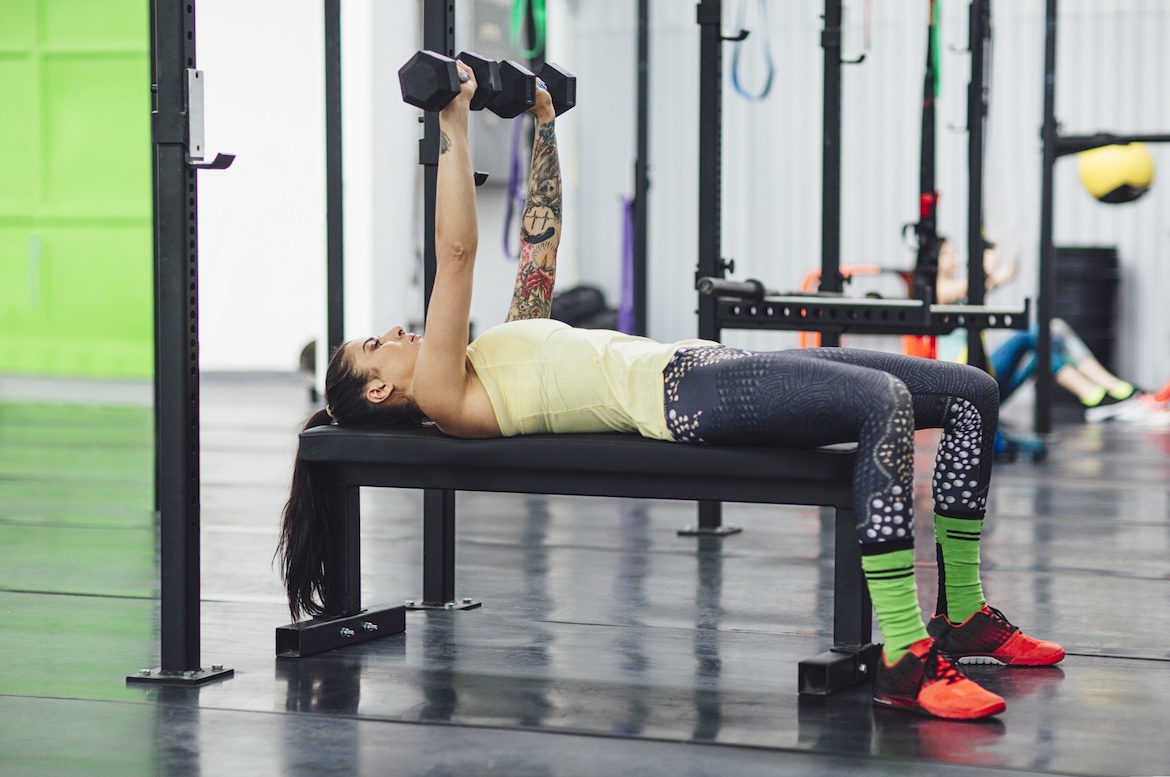If You’ve Ever Dreaded Doing Push-Ups During Burpees, the Squat Thrust Might Just Be the Move for You
Work every major muscle group in your body with this HIIT move.

The burpee has a reputation for being one of the hardest, most groan-worthy bodyweight exercises. It combines a squat, plank, and push-up, and adds a jump at the top for good measure. The result: A total-body move that builds strength and boosts stamina.
But the burpee isn’t for everyone. If you have a tough time getting through a rep with good form—or downright loathe the exercise—rest assured you can score similar benefits with less heartache. Wondering what to do instead of burpees? Give the squat thrust a try.
The squat thrust is a full-body exercise that closely mimics the challenge of a burpee—with a few exceptions.
Here, experts demonstrate squat thrust form, explain the benefits, and offer suggestions for getting the most out of the move.
How to do squat thrusts the right way
Jay Roman, CPT, a personal trainer at Life Time Buckhead at Phipps Plaza in Atlanta, breaks down the steps to performing a proper squat thrust.
- Stand tall with your feet shoulder-width apart, arms down by your sides.
- Bend your knees to squat down and place your hands on the ground in front of and just outside your feet.
- Hop both feet back so your legs are straight, keeping your wrists stacked under your elbows and your elbows under your shoulders. (Feel free to walk one foot back at a time if you’re unable to hop them back.) Engage your abdominals and squeeze your glutes to keep your hips level.
- Hop both feet forward and return to standing. (To make the exercise more challenging, jump as you return to standing.)
- Repeat.



Squat thrust vs. burpee: What’s the difference?
A squat thrust is essentially a burpee without the push-up. Both exercises are explosive and recruit multiple large muscle groups, making them effective ways to boost your heart rate. But omitting the push-up makes squat thrusts more accessible for those who struggle with the movement.
In addition, squat thrusts often exclude the jump that comes at the end of a burpee. The benefit of this is squat thrusts tend to be lower-impact, “which may make them a better option for those with joint issues,” says registered dietitian nutritionist and certified personal trainer Cassandra Padula Burke, RDN, CPT, owner of Catalyst Performance Lab in Finksburg, Maryland. That explosive jump at the top of a burpee is great for building power and jacking up your heart rate, but Padula Burke says it puts additional stress on your knees and ankles.
The benefits of adding squat thrusts to your workouts
One of the biggest perks of squat thrusts is they don’t require any equipment (though you can certainly incorporate weights if desired). “Squat thrusts are a versatile exercise you can do anywhere, making them perfect for busy gyms, home workouts, or hotel rooms,” Roman says.
By including the exercise in your workout repertoire, you can build strength in your lower body, Padula Burke says. In particular, you’ll hit your legs and glutes with the squat, and your core when you hop both feet back into plank.
Recruiting many muscles simultaneously and moving from standing to the ground and back to standing has the added effect of increasing your heart rate. Moving faster only amplifies the cardiovascular challenge, helping boost stamina.
In fact, researchers often use the squat thrust to evaluate endurance in study participants—men who can score 68 reps and women who get 64 reps in three minutes are said to have “good” endurance, according to international standards published in the Journal of Human Kinetics. Though the exercise is called a burpee, the technique used to set these standards doesn’t include the push-up or jump, making it a squat thrust.
And, of course, if you’d like to progress to burpees, nailing the squat thrust is a must. “Squat thrusts are one component of the burpee and are a great way to prepare for a full burpee,” says Portia Page, CPT, a certified personal trainer and Balanced Body educator.
Which muscles do squat thrusts work?
The squat thrust emphasizes your lower-body muscles but also incorporates your core and upper body, making it a great full-body movement, Padula Burke says.
Here are the muscles Padula Burke says you’ll work in each rep:
- Quadriceps: The squat, plank, and hop back lights up your quadriceps (quads), a group of muscles along the front of the thighs.
- Glutes: The muscles that make up your butt are targeted when you squat down and return to standing.
- Hamstrings: The hamstrings are muscles along the back of your thighs that help you squat, hold the plank, and hop back to stand.
- Shoulders: Your shoulders engage to help you hold the plank position.
- Triceps: These muscles in the back of your arms help stabilize your shoulders in the plank position.
- Chest: The large muscles in your chest assist with holding your upper body in place during the plank.
- Core: Your core muscles work at every phase of this exercise, from squatting down, to hopping back into a plank, to holding the plank, to hopping back into the squat.
“Squat thrusts are a versatile exercise you can do anywhere, making them perfect for busy gyms, home workouts, or hotel rooms.” —Jay Roman, CPT
3 variations of the squat thrust exercise
1. Squat thrust jack
“Squat thrust jacks are a great variation because they combine the dynamic movements of squat thrusts and jumping jacks, increasing cardiovascular intensity and engaging more muscle groups,” Roman says.

- Stand tall with your feet shoulder-width apart, arms down by your sides.
- Bend your knees to squat down and place your hands on the ground in front of and just outside your feet.
- Hop both feet back so your legs are straight, keeping your wrists stacked under your elbows and your elbows under your shoulders. (Feel free to walk one foot back at a time if you’re unable to hop them back.)
- Engage your abdominals and squeeze your glutes to keep your hips level as you hop your feet wide, and then back together.
- Hop both feet forward and return to standing. (To make the exercise more challenging, jump as you return to standing.)
- Repeat.
2. Squat thrust mountain climber
Incorporating mountain climbers into the squat thrust challenges your core muscles, improves agility, and boosts endurance, Roman says.

- Stand tall with your feet shoulder-width apart, arms down by your sides.
- Bend your knees to squat down and place your hands on the ground in front of and just outside your feet.
- Hop both feet back so your legs are straight, keeping your wrists stacked under your elbows and your elbows under your shoulders. (Feel free to walk one foot back at a time if you’re unable to hop them back.)
- Engage your abdominals and squeeze your glutes to keep your hips level as you pull one knee into your chest. Return your foot to the ground and quickly pull the opposite knee toward your chest.
- Hop both feet forward and return to standing. (To make the exercise more challenging, jump as you return to standing.)
- Repeat.
3. Weighted squat thrust
“Adding weight to squat thrusts can enhance the exercise’s intensity, leading to greater muscle activation,” Roman says. Choose hexagonal-shaped dumbbells instead of round ones so they don’t roll when you set them on the floor, and start with a lighter weight. Alternatively, you can wear a weighted vest.

- Stand tall with your feet shoulder-width apart, arms down by your sides. Hold a dumbbell in each hand, palms facing in.
- Bend your knees to squat down and set the dumbbells on the ground in front of and just outside your feet.
- Hop both feet back so your legs are straight, keeping your wrists stacked under your elbows and your elbows under your shoulders. (Feel free to walk one foot back at a time if you’re unable to hop them back.) Engage your abdominals and squeeze your glutes to keep your hips level.
- Hop both feet forward and return to standing. (To make the exercise more challenging, jump as you return to standing.)
- Repeat.
Common squat thrust mistakes to avoid
Typically, people make one (or both) of the following mistakes: dropping the hips while in the plank position and landing with their feet too close together or too far apart when hopping out of the plank.
Dropping your hips strains your lower back. Meanwhile, landing with your feet too close or too far apart stresses your knee and/or hip joints.
“To keep your hips from dropping, squeeze your core tight as you jump back,” Padula Burke suggests. If you still struggle, begin by stepping back into plank instead of jumping.
“For foot position, aim to land with your feet around shoulder-width apart,” Padula Burke says.
How to add the squat thrust to your routine
The squat thrust is a great exercise to add to a lower-body strength workout to challenge your glutes, legs, and core or to a circuit routine to quickly raise your heart rate.
“If squat thrusts are a new exercise for you, get comfortable with the movement by focusing on form rather than speed to reduce the risk of injury,” Padula Burke says.
Page suggests slowing down each portion of the exercise by walking your feet out to the plank and back into a low, deep squat. This can help you build strength, stamina, and coordination for faster movements while also helping you achieve the range of motion required to squat low.
Padula Burke suggests starting with two to three sets of eight reps and gradually increasing to 12 reps as your form improves when performing squat thrusts.
What's Your Reaction?







![Best Times to Post on YouTube in 2025 [Research]](https://www.hubspot.com/hubfs/best-time-to-post-youtube.jpg)

![12 Web Design Best Practices & Guidelines for Usability in 2025 [+ Expert Tips]](https://www.hubspot.com/hubfs/website-design-1-20241121-4075840.webp)










































































